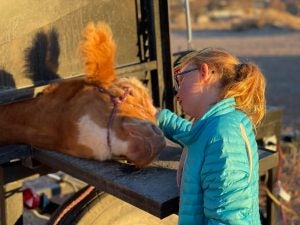The cedar fibers are laid down in the barn while days spanning sunrise to sunset become the norm for FFA and 4-H members completing livestock projects. For these members, vacations aren’t spent on the beach, instead they are spent carefully measuring feed, cleaning pens, rinsing, blowing, and repeating.
Feed is up, fuel is up, and our most precious commodity — time — is always ticking away. Last year’s banners are hanging in the aisleways collecting dust, and for some, tough lessons from an unsuccessful year linger. So, why do these youth and their families decide to measure their summers with hours spent in the barn aisle?

1. Livestock projects connect families
Whether showing a steer or smaller stock, livestock projects require a significant investment of time and labor — they’re a family affair. These hours spent in the barn aisle represent a unique opportunity for one-on-one time between members, parents, siblings, and everyone else invested in the member’s project. Anyone who has shown livestock is sure to remember one or two talking-tos and heart-to-hearts from the padded seat of a livestock trunk or the backseat of a pickup.
2. Raising livestock offers lessons in compassion
Few things in life so readily offer the opportunity to practice compassion as working with animals. Raising livestock has a way of amplifying all aspects of life, including sickness and death. By caring for another being’s needs, these young producers learn about looking beyond themselves each day as they step into the barn before breakfast.
» Related: The great 4-H debate: Which livestock barn is the coolest?
Youth experience the full circle of life by raising livestock projects. Projects usually begin while the animals are young. Members raise their livestock projects carefully to market weight, and then, at the end of the show season, load them onto a truck. The animals they have poured time and care into ultimately fulfill a purpose by going into the food supply chain.
3. Taking care of another living being teaches responsibility
Let’s be honest — most high school kids are not keen on the idea of jumping out of bed before the sun rises to feed, shovel excrement, and rinse animals. That is exactly what 4-H and FFA members across the country are doing each day to prepare for late summer and fall fairs. In raising livestock, members are learning about putting someone else’s needs before their own; the timeless rule that the animals get fed before we get fed prevails. For many youth, these livestock projects pave the way for real world and job experiences while members practice the discipline and responsibility associated with preparing for the show ring.
4. Showing helps youth learn about sweat equity
Raising animals is hard work. Many of these projects promise to build muscle and fortitude through manual labor. The youth who put in time and effort in the barn aisles this summer are rewarded with the ability to exhibit their products at the end of the project in the show ring. No matter the final outcome, the confidence that comes from knowing you’ve done your job well and being able to put what you’ve practiced on display is an irreplaceable lesson.
5. Winning gives youth members a chance to practice sportsmanship — losing educates them in humility
In a society that seems to be struggling with maintaining long-standing principles of humanity, lessons in sportsmanship and humility are invaluable. There is no better feeling than getting to shake the judge’s hand as he selects your animals during the grand drive as the best of its species. However, humility is rejuvenated by youth who also shake the judge’s hand and congratulate a fellow competitor when their animal doesn’t make the cut. Win or lose, youth can go home and put their tenacity into practice by applying lessons learned from last year’s show rings.
The memories and lessons learned in the show barn will last a lifetime. There are many reasons that families invest time and resources into livestock projects. When put into practice effectively, these lessons will often move youth toward a future where they can apply these same lessons in the workplace, volunteering, and raising their own families.
Heidi Crnkovic, is the Associate Editor for AGDAILY. She is a New Mexico native with deep-seated roots in the Southwest and a passion for all things agriculture.



